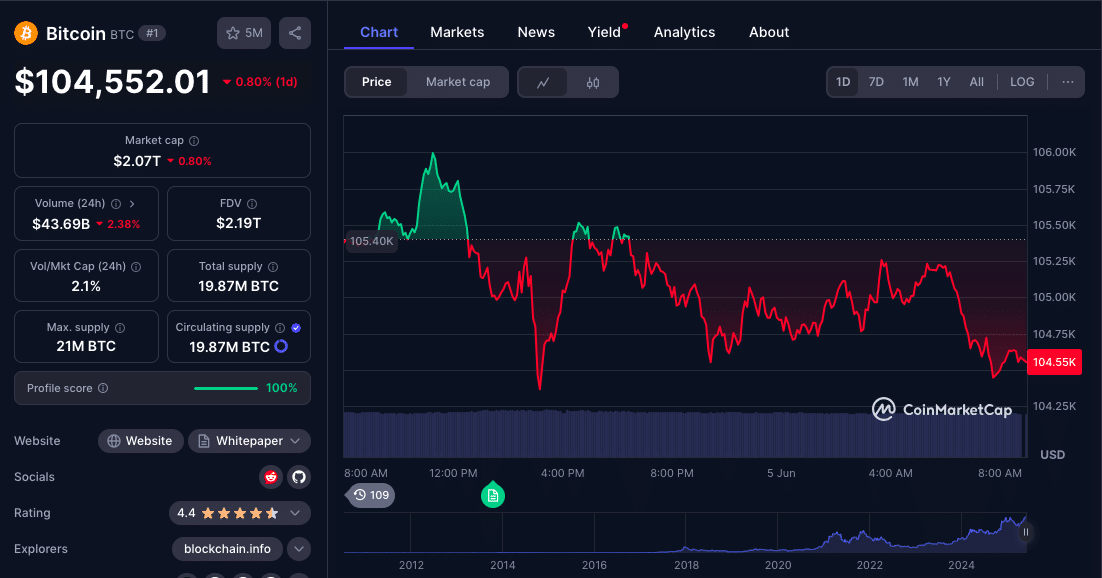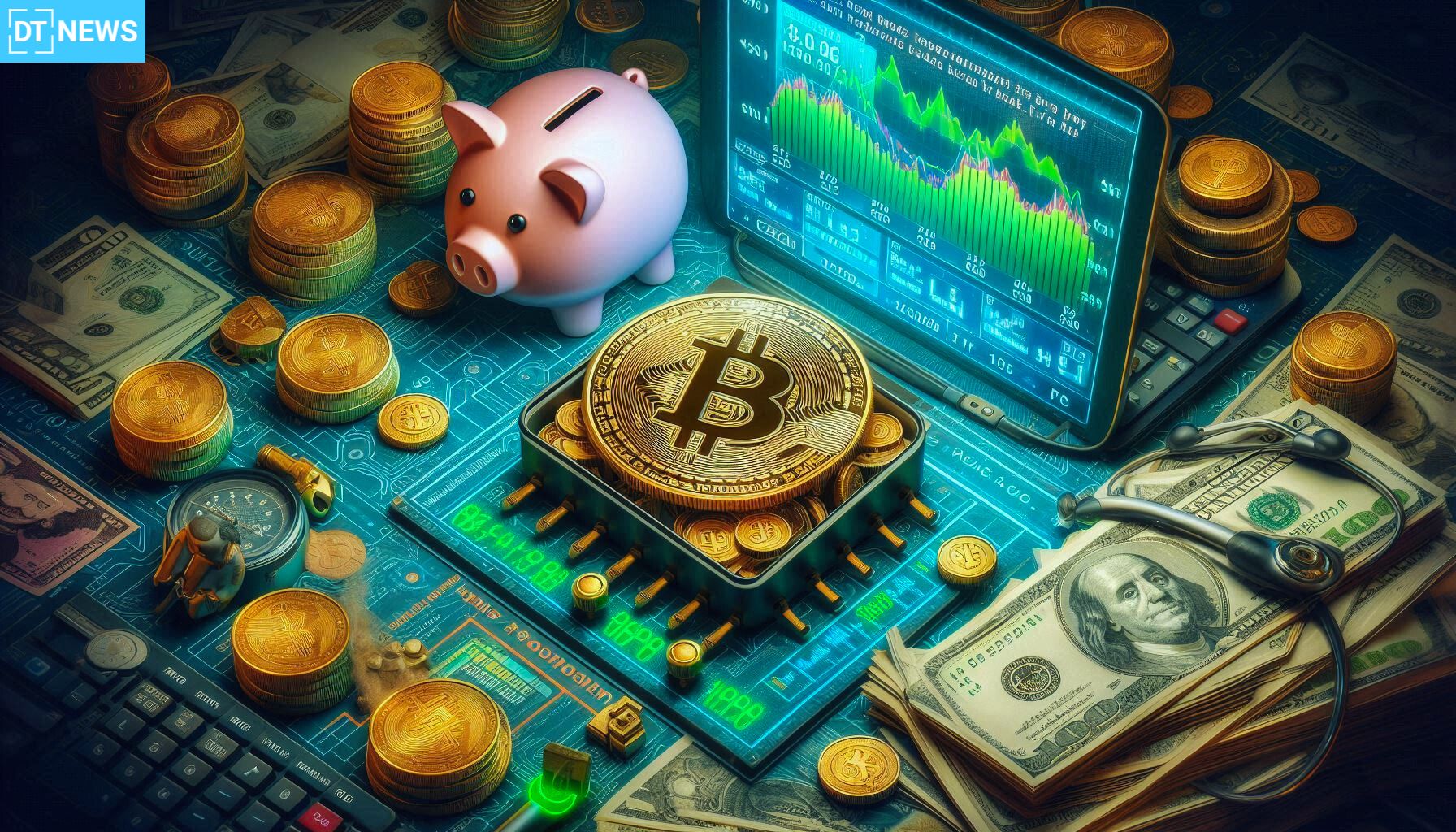Bitcoin’s all-time highs could be derailed or accelerated, depending on the US jobs report. Analysts say BTC is on the cusp of a breakout, but macro uncertainty remains. After a strong May, Bitcoin is consolidating around $104,000 after pulling back from nearly $112,000. While institutional interest and spot ETF inflows are strong, the next big upside may depend on one macro trigger which is the June 6 US jobs report.
- Bitcoin Below May High, But Sentiment Remains
- All Eyes on June 6: How the US Jobs Report Affects Bitcoin
- ETF Inflows and Institutional Demand is the Floor
- Technical Levels: $100K Floor and $115K Ceiling
- Real Vision: Bitcoin’s Q2 Surge Still in Play
- Conclusion: One Report, One Direction?
- FAQs
- Why is the US jobs report important for Bitcoin?
- What if the jobs data is better than expected?
- How much ETF flow did Bitcoin see in May?
- Can Bitcoin go below $100K?
- What’s the target if conditions align?
- Glossary
Bitfinex analysts say a weak print could push Bitcoin above $115,000 by July. But if the numbers move against the anticipated sentiment, rate cut hopes may fade and so might Bitcoin’s momentum.
Bitcoin Below May High, But Sentiment Remains
Bitcoin hit $111,970 on May 22 after $5.2 billion flowed into spot ETFs across the month, according to Farside Investors. Since then, it’s pulled back to around $104,000. The correction has raised questions if the bullish momentum is already running out of steam.
Despite the pullback, sentiment is still good. The Crypto Fear and Greed Index is at 55, still in “Greed” and indicating confidence in further gains hasn’t faded. Bitfinex analysts said the correction “has caused some concern,” but as long as macro conditions are good, investor optimism is still intact.

All Eyes on June 6: How the US Jobs Report Affects Bitcoin
The US jobs report has become an unlikely but crucial driver of crypto price action. A weak jobs number would fuel disinflation expectations and give the Fed more room to cut rates. That would weaken the US dollar and boost appetite for risk-on assets like Bitcoin.
“If the report comes in weak, we could see BTC test $115,000 or more by early July,” said Bitfinex analysts, citing continued ETF demand and institutional inflows as additional tailwinds.
On the other hand, a strong jobs report would confirm the Fed’s view of holding rates higher for longer. In that case, analysts warn Bitcoin could drop to $102,000 or even below $100,000. Bitfinex predicts a lower support zone between $95,000 and $97,000 where some accumulation may occur.
ETF Inflows and Institutional Demand is the Floor
The $5.24 billion in ETF inflows across May is still a long term support. BlackRock, Fidelity and other institutional players are now directly connected to daily Bitcoin market flows through their products, so bulls have some comfort.
“Bitcoin ETFs have changed the market structure,” said independent analyst Lauren Marks. “There’s now a floor of demand that didn’t exist before. If macro conditions line up we’re looking at a whole different ceiling.”
With the halving behind and miners adjusting to lower rewards, any reduction in sell pressure with stable or growing demand could squeeze supply, setting up a breakout if rate conditions improve.
Technical Levels: $100K Floor and $115K Ceiling
On the charts, the immediate support is at $102,000 with $100,000 being a big psychological level. Below that and the market could see more losses but analysts think the $95,000 to $97,000 range could be a strong buy zone.
Upside targets are at $110,000 and $115,000 if ETF flows continue and macro headwinds dissipate. Short term volatility will be around the US jobs report but longer term indicators are showing a battle between bulls who think the Fed will cut rates and bears who think the economy will be resilient.
Real Vision: Bitcoin’s Q2 Surge Still in Play
Some analysts like Real Vision’s Jamie Coutts think Bitcoin could still break to new all-time highs before the end of Q2. Speaking in March, Coutts said the market “may be underestimating how quickly Bitcoin can move” citing macro liquidity trends and capital rotation into hard assets.

With just weeks left in the quarter, BTC’s path to $115,000 might still be possible especially if the June US jobs report confirms slowing labor momentum and revives rate cut bets. But even bullish analysts warn nothing is guaranteed in this macro environment.
Conclusion: One Report, One Direction?
Bitcoin’s direction into July may be decided not on-chain but in Washington. The June 6 US jobs report will determine if rate cuts are a summer story or a Q4 discussion. For Bitcoin traders, this is not just economic data but directional fuel.
The trend is supported by ETF flows, institutional demand and sentiment. However, macro headwinds like a hawkish Fed or hot economic reports can cap the rally in the short term.
FAQs
Why is the US jobs report important for Bitcoin?
It impacts the Federal Reserve’s interest rate outlook. A bad report could boost rate cut expectations and be good for risk assets like Bitcoin.
What if the jobs data is better than expected?
A strong labor market could delay rate cuts, strengthen the dollar and put pressure on Bitcoin’s price.
How much ETF flow did Bitcoin see in May?
Bitcoin spot ETFs saw around $5.24 billion in inflows which helped it rally to $112,000.
Can Bitcoin go below $100K?
Yes. If macro gets tight, analysts say Bitcoin could test levels as low as $95,000.
What’s the target if conditions align?
Bitfinex analysts think Bitcoin could reach or go above $115,000 by early July in a bull scenario.
Glossary
ETF (Exchange-Traded Fund): A type of investment fund traded on stock exchanges, holding assets such as stocks or cryptocurrencies.
Federal Reserve (Fed): The central banking system of the US, which sets interest rates and monetary policy.
Disinflation: A slowdown in inflation, often seen as easing economic pressure.
Fear and Greed Index: A metric that measures investor sentiment in the crypto market, from extreme fear to extreme greed.
Institutional Demand: Interest in crypto from large entities like hedge funds, banks or asset managers, typically through ETFs or OTC desks.



















































































































